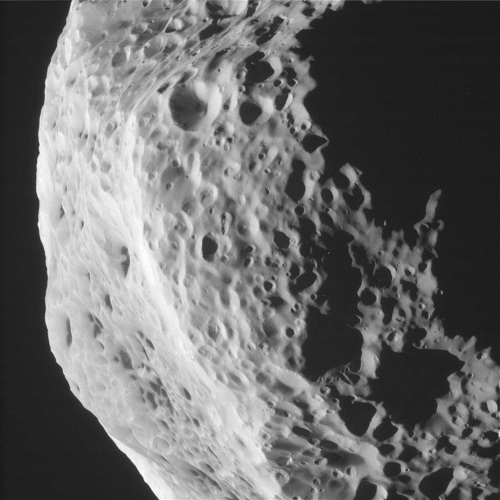We can thank the British astronomer John Herschel (1792-1871) for giving the moons of Saturn their classical theme, resulting in the familiar names Mimas, Dione, Enceladus, Tethys, Titan, Rhea, and Iapetus for the seven moons known to him when he wrote his Results of Astronomical Observations Made at the Royal Observatory, Cape of Good Hope (1847). It was a natural, then, that the moon discovered shortly thereafter would get a name like Hyperion (although it wasn’t Herschel but merchant and astronomer Willam Lassell who suggested the name). Hyperion was an elder brother of Cronos (Saturn), and was associated with watchfulness and observation.
Only recently have we discovered just how unusual Hyperion turns out to be, as the unprocessed image from the Cassini mission below clearly demonstrates. Its shape is irregular, indicating it may be the remnant of a larger body broken by some ancient impact. Its low density indicates large amounts of water ice mixing with small amounts of rock. Its low albedo suggests a layer of dark material that may be associated with Saturn’s moon Phoebe, much of which seems to have wound up on Iapetus. And it resembles nothing so much as an enormous sponge.

Image: NASA’s Cassini spacecraft obtained this unprocessed image of Saturn’s moon Hyperion on Aug. 25, 2011. Image credit: NASA/JPL-Caltech/Space Science Institute.
You can see more images of Hyperion from the encounter here. The image above was made as the spacecraft flew past Hyperion at some 25,000 kilometers. We’re looking at a very small place, some 270 kilometers across, and a world that tumbles chaotically in its orbit around Saturn, the motion making it difficult for scientists to predict what Cassini would see as it set about imaging the moon on this flyby. Color measurements made during this observation run will tell us much about the moon’s brightness as lighting changes, which in turn should offer some insight into its surface texture.
Back in 2007 the analysis of data from a 2005 Cassini flyby pointed to a surface composition of water and carbon dioxide ices along with the hitherto mentioned dark material that Dale Cruikshank (NASA Ames), lead author of the paper on that study, found interesting:
“Of special interest is the presence on Hyperion of hydrocarbons — combinations of carbon and hydrogen atoms that are found in comets, meteorites, and the dust in our galaxy. These molecules, when embedded in ice and exposed to ultraviolet light, form new molecules of biological significance. This doesn’t mean that we have found life, but it is a further indication that the basic chemistry needed for life is widespread in the universe.”
Many of Hyperion’s craters appear to be crisply defined, evidently the result of the moon’s low density. Just half as dense as water, Hyperion is porous enough to compress when struck by debris, but the ejecta of an impact often fails to return to the surface because of the moon’s low gravity. Denser worlds usually lack a large population of craters with such crisp visual definition.
Two papers on that earlier Hyperion work go into detail on all this. They are Cruikshank et al., “Surface composition of Hyperion,” Nature 448 (5 July 2007), pp. 54-56 (abstract) and Thomas et al., “Hyperion’s sponge-like appearance,” Nature 448 (5 July 2007), pp. 50-56 (abstract). A slightly later summary of the dark coating we see on various Saturnian moons can be found in Saturn’s Dark Materials, a Centauri Dreams article in which I look at research from 2008.



“Only recently have we discovered just how unusual Hyperion turns out to be…”
Not quite. Hyperion has long been known to have one very peculiar attribute that made it an object of interest: a chaotic rotation period. That’s due to a combination of strong gravitational influences and its highly-irregular shape.
Hyperion, a world where the weather forecast is more reliable than the sunrise forecast…
So, who thinks it is a giant comet remnant? :)
I always loved Hyperion since Cassini took the first pictures of it, it’s an amazing little world.
There is an interesting paper from 2001 by Michael Berry about Hyperion’s orbit “Chaos and the semiclassical limit of quantum mechanics (is the moon there when somebody looks?)”
http://www.phy.bris.ac.uk/people/berry_mv/the_papers/berry337.pdf
mentioned in John C. Baez’s 223rd Week:
http://math.ucr.edu/home/baez/week223.html
the radiation around Jupiter is so intense ( in certain areas) that sending astronauts to explore the inner moons is pretty much out of the question for the Foreseeable future . I am not sure whet the situation is around Saturn with the distance form the sun and the different configuration to the magnetic field and the presence of the rings is this still true? The distance is immense to mount a manned mission using chemical or solar powered ion drives. We will probably see only robotic mission for the next three decades or more, but what about the next 50 years? might these moons be explored and settled is there too much debris in the system from the rings to risk a crew? how well has the radiation been mapped?
Hyperion has been known as the “battered hockey puck” since the days of Voyager, which first revealed its unusual shape. Had Hyperion been much smaller, that moon probably would not have survived at all as a testament to how rough things were in the Sol system in the way old days.
“So, who thinks it is a giant comet remnant?”
Me! At least based on what I’ve seen and read so far.
Question would then be how do you end up with a comet getting captured into the outer 3:4 orbital resonance with Titan.
This colorized movie of the Hyperion flyby was composed using 85 frames taken with Cassini’s narrow angle camera (NAC):
http://youtu.be/ARyY7BJhzhs?hd=1